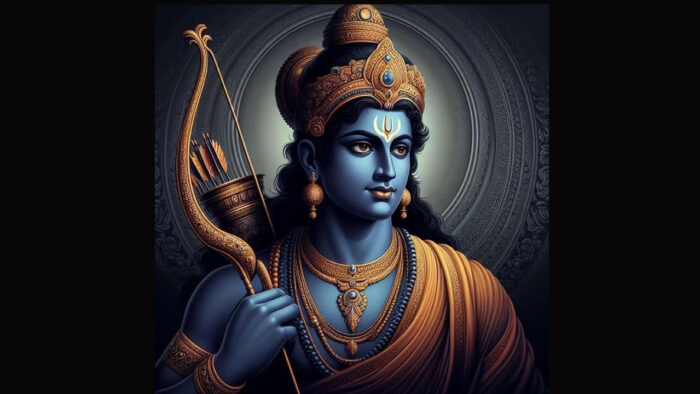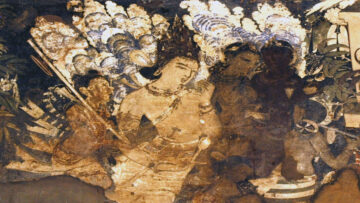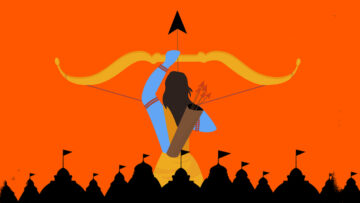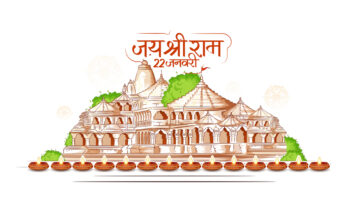As we continue to revel in the splendid inauguration of the Rama Mandiram in Ayodhya, a momentous and divine occasion, it is an opportune time to immerse ourselves in the exploration of Rama Bhakti within the enchanting realm of Carnatic music that is popular in Southern India. At the very core of Shastriyasangeetam lies the rich and vibrant tradition of Carnatic music, a form that embodies the essence of devotion and spirituality.
The revered Saint Thyagaraja, Muthuswamy Dikshitar, and Shyama Shastri are not just luminaries but are venerated as the Trimurtis of Carnatic Music. Their profound contributions have forever transformed and uplifted the landscape of Indian classical music. Each composition they crafted is a gem, imbued with deep devotion (Bhakti) and can invoke a similar sense of devotion and spiritual awakening in those who listen.
In this article, we shall embark on a journey through the heart of Carnatic music, exploring some of the most sublime and spiritually charged compositions of Saint Thyagaraja, dedicated to Lord Rama in Samskritam. While the majority of Saint Thyagaraja’s compositions are in Telugu, there exist some exceptional gems in Samskritam that captivate and steal the hearts of listeners. These masterpieces are not just songs; they are soulful expressions of Bhakti, each lyric and note resonating with the profound love and reverence for Lord Rama. Through the exploration of these divine melodies, we seek to understand not just the musical genius of this great composer, but also the depth of Rama Bhakti that permeates through Carnatic music, touching the hearts and souls of listeners across generations.
Saint Thyagaraja’s devotion to Lord Rama was so profound and heartfelt that it found its most beautiful expression in the song “Sita (Rama) Kalyana Vaibhogame” where he is celebrating the divine union of Lord and Lordess in this incarnation. Its melody and lyrics have captivated hearts so deeply that the song has blossomed into numerous variations, each echoing the same fervent devotion. Today, “Sita (Rama) Kalyana Vaibhogame” has become synonymous with auspicious beginnings, often sung by families to invoke blessings and joy during significant and celebratory occasions.
In the mesmerizing first charanam, Saint Thyagaraja paints a celestial portrait of Lord Rama with his devotional words,
“पवनजस्तुतिपात्र! पावनचरित्र! रविसोमवरनेत्र! रमणीयगात्र!”
(“pavanajastutipātra! pāvanacaritra! ravisomavaranetra! ramaṇīyagātra!”)
He venerates Rama as the divine being, extolled by Hanuman, the son of the wind. The purity and sanctity of Rama’s character are exalted, untouched and pristine. Thyagaraja then beautifully describes Rama’s eyes, as radiant and calming as the sun and the moon. Finally, he adores Lord Rama’s form, a vision of divine beauty, enchanting and sublime, capturing the essence of heavenly grace.
Among the revered works of Saint Thyagaraja, the “PancaratnaKritis” stands as a monumental testament to his musical and devotional genius. These kritis are not just compositions but are considered vital pillars of learning for every student of Carnatic music. They are soulfully rendered each year during the aradhana of Saint Thyagaraja at his birthplace in Thiruvaiyaru, Tamil Nadu, creating an atmosphere of divine reverence.
In the first of these kritis, “Jagadanandakaraka,” composed in the classical language of Samskritam, Thyagaraja offers a sublime portrayal of the epic Ramayana. Within one of its charanams, he exquisitely praises Lord Rama with the lines:
इन्द्रनीलमणिसन्निभापघन! चन्द्रसूर्यनयन! अप्रमेय! वागीन्द्रजनक!
सकलेश! शुभ्र! नागेन्द्रशयन! शमनवैरिसन्नुत!
(indranīlamaṇisannibhāpaghana! candrasūryanayana! aprameya! vāgīndrajanaka! sakaleśa! śubhra! nāgendraśayana! śamanavairisannuta!)
In these heartfelt words, Thyagaraja depicts Lord Rama as the embodiment of celestial beauty, likening Him to the lustrous Indranila gemstone. He marvels at Rama’s eyes, as radiant and nurturing as the sun and moon, and extols Him as immeasurable and beyond comprehension. Thyagaraja acknowledges Rama as the divine overseer of Brahma. Rama is the lord of all existence, radiating purity and brilliance. He also reveres Rama’s serene repose on the celestial serpent Adisesha and celebrates His exaltation by Lord Shiva. This verse is not just a praise but a poetic encapsulation of Lord Rama’s divine virtues, reflecting Thyagaraja’s deep-seated devotion and adoration.
In the heartfelt composition “Sri Rama RamaJagadAtma,” Saint Thyagaraja pours out his soul in a poignant declaration of his unwavering devotion to Lord Rama. He sings,
त्वांविनानान्यत्रजानेराम! त्वांविनाकोगतिर्जानकीजाने!
(tvāṃvinānānyatrajānerāma! tvāṃvinā ko gatirjānakīkāne!”)
These lines express his profound realization that beyond Rama, he knows no one else, and without Rama, he sees no other refuge. These lyrics are not merely a statement but an outpouring of Thyagaraja’s soul, resonating with intense bhakti. The earnestness with which he declares his exclusive devotion to Rama, acknowledging Him as his sole sanctuary and guide, is deeply moving. His cry, filled with longing and devotion, touches the listeners, often moving them to tears, as they too are drawn into the depths of such pure and unconditional love for Lord Rama.
Saint Thyagaraja’s oeuvre in Telugu, dedicated to the adoration of Lord Rama, is replete with magnificent compositions that resonate deeply within the soul. Among these, “BantureetiKolu,” “Yochana kamala,” “Melukovayya,” “VandhanamuRaghunandana,” “Appa Rama Bhakti,” “BrovaBarama,” ,”Brochevaarevare”, ”Nagumomu” and many more stand out as shining examples. These pieces have the power to envelop listeners in their soul-stirring melodies and profound devotion, even to those unacquainted with the Telugu language,.
To contemplate Carnatic music without the essence of Bhakti is to overlook the very foundation upon which it stands. Bhakti is not just an element; it is the soulful core that breathes life into music and singing. To suggest otherwise would be a disservice to the truth. Removing Bhakti from these compositions would not only diminish their beauty but would also do a great injustice to Saint Thyagaraja and his devout legacy. His music transcends linguistic boundaries, inviting all to experience the universal and timeless appeal of divine love and devotion.
I conclude this article with heartfelt prayers and by singing “Nitya Mangalam” and “Jaya Mangalam” to Lord Rama. May our devotion to the divine flourish evermore as we immerse ourselves in the singing and listening of these sublime compositions. Through the grace of these musical offerings, let us find our hearts and spirits uplifted, our Bhakti deepened, and our lives enriched with the eternal blessings of Lord Rama.
Disclaimer: The opinions expressed in this article belong to the author. Indic Today is neither responsible nor liable for the accuracy, completeness, suitability, or validity of any information in the article.










